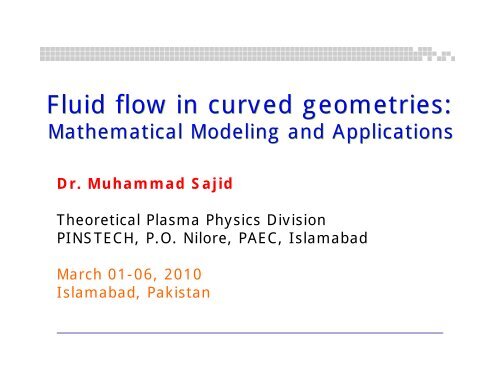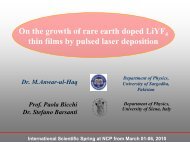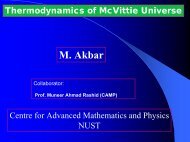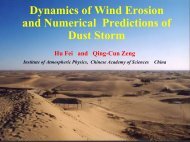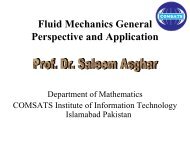Fluid flow in curved geometries
Fluid flow in curved geometries
Fluid flow in curved geometries
Create successful ePaper yourself
Turn your PDF publications into a flip-book with our unique Google optimized e-Paper software.
Presentation LayoutAnalysis of fluid behaviourGovern<strong>in</strong>g equationsManifold and Metric∇ operationsStretch<strong>in</strong>g a <strong>curved</strong> surfacePeristaltic <strong>flow</strong> <strong>in</strong> a <strong>curved</strong> channelSummary
Analysis of fluid behaviour Analysis of any problem <strong>in</strong> fluid mechanicsnecessarily <strong>in</strong>cludes statement of the basic lawsgovern<strong>in</strong>g the fluid motion. The basic laws, whichapplicable to any fluid, are:Conservation of massNewton’s second law of motionThe pr<strong>in</strong>ciple of angular momentumThe first law of thermodynamicsThe second law of thermodynamics
Analysis of fluid behaviour NOT all basic laws are required to solve any oneproblem. On the other hand, <strong>in</strong> many problems itis necessary to br<strong>in</strong>g <strong>in</strong>to the analysis additionalrelations that describe the behavior of physicalproperties of fluids under given conditions. Many apparently simple problems <strong>in</strong> fluidmechanics that cannot be solved analytically.In such cases we must resort to morecomplicated numerical solutions and/orresults of experimental tests.
Manifold and metricWhat is a manifold?A manifold is a geometric ‘th<strong>in</strong>g’ which hasopen charts, subsets where a flat set ofcoord<strong>in</strong>ates is given. In general, however,they can be built by patch<strong>in</strong>g together on atlasof open charts.We need to review open charts
Open charts:Manifold and metricThe same po<strong>in</strong>t is conta<strong>in</strong>ed <strong>in</strong> more than one openchart. Its description <strong>in</strong> both charts is related by acoord<strong>in</strong>ate transformation
Manifold and metricDifferentiable structure
Manifold and metricDifferentiable structure
ManifoldManifold and metricParallel transportA vector field is parallel transported along a curve,when it manta<strong>in</strong>s a constant angle with the tangentvector to the curve
Manifold and metricThe metric: a rule to calculate the lenghtof curves!!Connection and covariant derivativeA connection is a map∇:TM× TM→TMFrom the product of thetangent bundle with itself tothe tangent bundle
In a basis...Covariant derivativeThis def<strong>in</strong>es the covariant derivative of a (controvariant) vector field<strong>Fluid</strong> Mechanics Group (FMG)14
Covariant derivativeCovariant derivative of a general tensorVector (first order tensor, r + s = 1)ii ∂Ai n ∂AiA, m= + ΓnmA ; Ami ,m= − Γm∂ξ∂ξ• Second-order tensor (r + s = 2)nimAnijij ∂Ti nj jT,m= + ΓnmT+ Γ Tmnm∂ξ∂TijnnTij,m= − ΓimTnj− ΓjmTm<strong>in</strong>∂ξii∂T•j i n nT• j ,m= + ΓnmTj jmTm•− Γ∂ξ<strong>in</strong>i• netc.r = 2, s = 0r = 0, s = 2r = 1, s = 1
For the velocity field∇ operationsV =i jV ( u )Gradient of the velocity field iseiLiik= ∇V= V ; j = g gjmm,[( )]mmm llg V k + Γ g VlklDivergence of the velocity field isi∇ ⋅ V = V ; i = ,( )iii mmg Vii + Γmig VmWhere ; represent the covariant derivative
Divergence of a tensor∇ ⋅ T =( ) [( )]kk ii jji mm jj j ii mmV⋅ ∇ T = g g g V g g T , k + Γ g g T + Γ g g Tiijjgiik( )ii jjg g T⎡⎢⎢⎣+ Γjmj(V⋅∇) of a vectorijgiiijg,jmmmk+ ΓTim( )( )ii kk∇ V = g g V g VV⋅ ,kk(V⋅∇) of a tensor∇ operationsiimjgmmmjgjjmkTmj[ ]k mmi + Γ g Vkmi⎤⎥⎥⎦mim
Stretch<strong>in</strong>g a <strong>curved</strong> surfaceGeometry of the problemFig. 1 (a)Fig. 1 (b)r, vs, uRO(a) a flat stretch<strong>in</strong>g sheet, (b) a <strong>curved</strong> stretch<strong>in</strong>g sheet.
Stretch<strong>in</strong>g a <strong>curved</strong> surfaceMathematical FormulationCurvil<strong>in</strong>ear coord<strong>in</strong>ates ( r + R,s)metriccont<strong>in</strong>uity equationg ab⎛1⎜⎝0=2∂∂r0⎞( r + R) ⎟⎠∂u∂s{( r + R)v} + R = 0,components of equation of motion2u 1 ∂p=r + R ρ ∂r,v∂u∂r+Rur + R∂u∂s+uvr + R1= −ρ rR+ R∂p∂s⎛+ ν⎜⎝2∂ u2∂r+r1+ R∂u∂r−( ru+ R)2⎞⎟,⎠
Stretch<strong>in</strong>g a <strong>curved</strong> surfaceThe boundary conditions applicable to the present<strong>flow</strong> areuas,u → 0,∂u∂rUs<strong>in</strong>g the similarity transformationu = asf ′The problem takes the form=Rr + Rv=0atr=0,→ 0 as r → ∞.2 2( η ),v = − aνf ( η) , p = ρas P(η),η = r.2kf ′′P = f ′′′ + −η + k η + kf ′( η + k)kη + k2∂Pf ′=∂ηη + kkη + kk( η + k)′ 2− f + ff + ff2 2′′aν′,ff =′ →0,0,ff′ = 1 at η = 0,′′ → 0 as η → ∞,
Stretch<strong>in</strong>g a <strong>curved</strong> surfaceElim<strong>in</strong>at<strong>in</strong>g pressuref iv2 f ′′′+η + k−f ′′ f ′ kk ′ 2k+ − ( f f′′′ − ff ′′′ ) − ( f − ff ′′)− ff ′ = 0.2 323( η + k)( η + k)η + k( η + k)( η + k)The sk<strong>in</strong> friction coefficientf ′(0)1Re 1 / 2xC f= f ′′(0)+ = f ′′(0)k+ kIt is important to po<strong>in</strong>t out that the Crane’sproblems can be recovered by tak<strong>in</strong>g k → ∞ . Thenumerical solution of the problem is developed by ashoot<strong>in</strong>g method us<strong>in</strong>g a Runge-Kutta algorithm.
Stretch<strong>in</strong>g a <strong>curved</strong> surface1.00.81.21.0k = 1000 ; k = 20 ; k = 10 ; k = 50.60.8f 'HhL0.4k = 1000 ; k = 20 ; k = 10 ; k = 5f HhL0.60.40.20.20.00 1 2 3 4 5 6h0.00 1 2 3 4 5 6hr-component of velocity, s-component of velocity
Stretch<strong>in</strong>g a <strong>curved</strong> surfacePHhL0.020.00-0.02-0.04-0.06-0.08-0.10k = 1000 ; k = 20 ; k = 10 ; k = 50 1 2 3 4 5 6Dimensionless pressurehk1/2−C f Re x5 0.7576310 0.8734920 0.9356130 0.9568640 0.9675950 0.97405100 0.98704200 0.993561000 0.99880Sk<strong>in</strong> friction coefficient
Peristaltic <strong>flow</strong> <strong>in</strong> a <strong>curved</strong> channelGeometry of the problem⎡2π( ) = + ( − )⎤H X, t a bs<strong>in</strong> ⎢ X ct , Upper wall⎣ λ ⎥⎦⎡2π( ) ( )⎤− H X, t =−a−bs<strong>in</strong> ⎢ X −ct. Lower wall⎣ λ ⎥⎦
Peristaltic <strong>flow</strong> <strong>in</strong> a <strong>curved</strong> channelMathematical FormulationGovern<strong>in</strong>g equations <strong>in</strong> fixed frame:∂∂R{( ) }R R V R∂U+ * + * =∂X*2V V R U V U p 1V+ V + − =− + R + R* * *∂ ∂ ∂ ∂ *ν ⎡ ∂ ⎧ ∂ ⎫⎢ ⎨( ) ⎬∂t ∂ R R + R ∂ X R + R ∂ R ⎢⎣R + R ∂R⎩ ∂R⎭*22 *⎤⎛ R ⎞ ∂ V V 2R ∂U+ ⎥⎜ ,* ⎟ − +2 2 2R R * *⎝ + ⎠ ∂ X ( R R) ( R R)∂X⎥+ + ⎥⎦* *∂U ∂U R U ∂U UV R ∂p 1* UV ν ⎡ ∂ ⎧ ∂ ⎫+ + − =− +* * *⎢* ⎨( R+R ) ⎬∂t ∂ R R+ R ∂ X R+ R R+ R ∂ X ⎢⎣R+ R ∂R⎩ ∂R⎭*22 *⎤⎛ R ⎞ ∂ U U 2R ∂V+ ⎥⎜ .* ⎟ − +2 2 2R R * *⎝ + ⎠ ∂ X ( R R ) ( R R )∂X⎥+ + ⎥⎦0,
Peristaltic <strong>flow</strong> <strong>in</strong> a <strong>curved</strong> channelGovern<strong>in</strong>g equations <strong>in</strong> wave frame:∂∂r{( ) }r R v R( ) ( )*R u c u c∂u+ * + * =2∂v ∂v + ∂v + ∂p ⎡ 1 ∂ ⎧* ∂v⎫− c + v + − =− + ν* *⎢* ⎨( R + r)⎬∂x ∂ r R + r ∂ x R + r ∂ r ⎢⎣R + r ∂r ⎩ ∂r⎭*22 *⎤⎛ R ⎞ ∂ v v 2R ∂u+ ⎥⎜ ,* ⎟ − +2 2 2R r * *⎝ + ⎠ ∂ x ( R r) ( R r)∂x⎥+ + ⎥⎦( ) ( )**∂u ∂u R u+ c ∂u u+ c v R ∂p ⎡ 1 ∂ ⎧* ∂u⎫− c + v + − =− + ν* * *⎢* ⎨( r+R ) ⎬∂x ∂ R R+ R ∂ x R+ R R+ R ∂ x ⎢⎣r+ R ∂r ⎩ ∂r⎭*22 *⎤⎛ R ⎞ ∂ u u 2R ∂v+ ⎥⎜ .* ⎟ − +2 2 2v R * *⎝ + ⎠ ∂ x ( r R ) ( r R )∂x⎥+ + ⎥⎦∂x0,
Peristaltic <strong>flow</strong> <strong>in</strong> a <strong>curved</strong> channelNon-dimensional variables:2πx r u v ρcax= , η = , u = , v= , Re = ,λ a c c µ2 *2πa H RP = p, h= , k = ,λµ c a aStream function: ∂ψk ∂ψ2u =− , v=δ where δ =∂ η η+ k ∂xUnder the long wavelength approximation we have∂ P = 0,∂η2∂P1 ∂ ⎧ ∂ψ⎫ 1 ⎛ ∂ψ⎞− − ⎨( η + k )1 0.2 ⎬− ⎜ − ⎟=∂x k ∂η ⎩ ∂ η ⎭ k( η+ k)⎝ ∂η⎠π a.λ
Peristaltic <strong>flow</strong> <strong>in</strong> a <strong>curved</strong> channelElim<strong>in</strong>at<strong>in</strong>g pressure⎧ ⎫ ⎧ ⎛ ⎞⎪⎫⎨ + ⎬+ ⎨ 1− ⎟⎬=0.∂ ⎩ ∂ ⎭ ∂ ⎪⎩( + k)⎝ ∂ ⎠⎪⎭2 21 ∂ ∂ ψ ∂ ⎪ 1 ∂ψ2( η k )2⎜k η η η η ηq ∂ψψ =− , = 1 at η = h= 1+φs<strong>in</strong> x,2 ∂ηq ∂ψψ = , = 1 at η =− h=−1−φs<strong>in</strong> x,2 ∂ηSolution of the problemC( ) ( ( ) ) ( ) 2 ( ) 2C ⎧1 ⎪η+ k ⎫⎪η+kψ = η+ k + ⎨ ln η+ k − 1 ⎬+ C + C ln ( η+ k)+ C2 ⎪⎩2 ⎪⎭42 3 4C ⎡η+ k η+k C3⎤u = + ( η k) { ( η k)} C22⎢ + + + − + +2 2 η + k⎥⎣⎦11 ln 1 .( )− 8hk 2h + q=− 4hk + h −k ln k− h + ln k+ h −2 h −k ln k− h ln k+h2 2( ) ( ) ( ) ( )( ) ( ) ( )1 2 2 2 2 2 2 22
Peristaltic <strong>flow</strong> <strong>in</strong> a <strong>curved</strong> channeldp=CC( )2 2( ) ( ) ( ) ( )2 2( h q) hk ( k h) ( k h) ( k h) ( k h)− 2 2 + 2 + − ln − − + ln +=− 4h k + ( h −k ) ln( k− h) + ln( k+ h)−2 h −k ln k− h ln k+h2 22 ⎛k−h⎞( h − k ) ( 2h+ q)ln⎜ ⎟k+h=⎝ ⎠2 2 2 2 2 22 2− 4h k + h −k ln k− h + ln k+ h −2 h −k ln k− h ln k+h22 2 2 222 22( ) ( ) ( ) ( )( ) ( ) ( )3 2 2 2 2 2hk ( h hk h q k q) ( h k )3 2 22 ⎛k−h⎞2 2 − 2 + + + − ln⎜⎟×⎝k+h⎠( −2h− q+ ( 2( h+ k)+ q) ln ( k− h) + ( 2h− 2k+ q) ln ( k+h))C4 =−2 2 2 22 2 22 222( − 4h k + ( h −k ) ( ln ( k− h) + ln ( k+ h)) −2( h −k ) ln ( k− h) ln ( k+h))The axial pressure gradient turned out to be( + )8h 2h q2 2( ) ( ) ( ) ( )( ) ( ) ( )dx 2 2 2 222 224 h k h k ln k h ln k h 2 h k ln k h ln k h− + − − + + − − − +The dimensionless pressure rise over onewavelength is def<strong>in</strong>ed by 2∆ Pλπ= ∫0dpdxdx.
Peristaltic <strong>flow</strong> <strong>in</strong> a <strong>curved</strong> channel
Peristaltic <strong>flow</strong> <strong>in</strong> a <strong>curved</strong> channelk = 3.5k = 5k =10k →∞
Summary The ∇ operations for curvil<strong>in</strong>earcoord<strong>in</strong>ates have been discussed. Flow of a viscous fluid due toStretch<strong>in</strong>g a <strong>curved</strong> surface isanalyzed.Peristaltic <strong>flow</strong> <strong>in</strong> a <strong>curved</strong> channel is<strong>in</strong>vestigated.
Thank You!


